bajra flour

Table of Content
What is bajra flour, bajra ka atta, bajre ka atta?
Bajra flour, commonly known as pearl millet flour in English, holds a significant and historically rich place in the Indian dietary landscape. It is derived from the small, round grains of the bajra plant (Pennisetum glaucum), a drought-tolerant crop that thrives in arid and semi-arid regions. Unlike wheat, bajra is naturally gluten-free, making it an invaluable grain for individuals with gluten sensitivities or celiac disease. The flour, typically grayish in color, possesses a distinct nutty flavor and is widely recognized for its "heating" properties, making it a popular choice, especially during the colder winter months across various parts of India.
The cultivation of bajra in India dates back thousands of years, primarily concentrated in states like Rajasthan, Gujarat, and Maharashtra, where the dry climate is conducive to its growth. This deep historical root has firmly embedded bajra flour into the traditional cuisines of these regions. It's not just a food source but a cultural staple, often associated with a wholesome, rustic, and energy-giving diet, particularly for communities engaged in strenuous physical labor.
In North India, especially in Rajasthan and parts of Gujarat, Bajra Roti or Bajra no Rotlo (a thicker, unleavened flatbread) is perhaps the most iconic use of bajra flour. These robust rotis are often cooked on a tava and served generously slathered with ghee (clarified butter), accompanied by hearty vegetable curries like gatte ki sabzi, garlic chutney, or Sarson da Saag (mustard greens curry) in winter. The combination provides warmth and sustained energy, making it a comforting and nutritious meal.
Moving towards Western India, particularly Maharashtra and parts of Gujarat, bajra flour is also central to dishes like Bhajani Thalipeeth, a multi-grain flatbread often incorporating bajra with other flours like jowar and besan, along with various spices and vegetables. This not only adds to its nutritional profile but also offers a diverse texture and flavor. Bajra is also used to make savory porridges (like ghugri) or even sweet dishes like laddus in some regions, showcasing its versatility beyond just flatbreads.
Across other parts of India, while not always a staple bread, bajra flour finds its way into various preparations. It can be used to make Bajra Khichdi, a wholesome one-pot meal cooked with lentils and vegetables, providing a complete nutritional profile. Its gluten-free nature has also seen its rising popularity in modern Indian kitchens, where it's being incorporated into healthier versions of common snacks, baking, and even as a base for gluten-free pancakes or porridges, moving beyond its traditional flatbread applications.
From a nutritional perspective, bajra flour is a powerhouse. It is rich in dietary fiber, which aids digestion, promotes satiety (beneficial for weight management), and helps regulate blood sugar levels, making it an excellent choice for diabetics. It's also a good source of protein, essential minerals like magnesium, iron, phosphorus, and zinc, and B vitamins. Its high magnesium content is particularly beneficial for heart health, aiding in blood pressure regulation. These numerous health benefits, combined with its ability to grow in challenging agricultural conditions, underscore why bajra flour continues to be a vital and cherished component of the Indian diet.
Also Known as
Black Millet flour, Pearl Millet flour
How to select bajra flour, bajra ka atta, bajre ka atta
• The quality of the bajra determines the quality of the flour and thus one should ensure that you purchase the flour from a trustworthy grocery store.
• Do check the manufacturing date and expiry date before purchasing.
Culinary Uses of bajra flour, bajra ka atta, bajre ka atta in Indian Cooking
• Bajra flour is combined with wheat flour or jowar flour to make bhakri, theplas, bajra na rotla and other breads.
bajra roti recipe | bajre ki roti | healthy pearl millet roti | Rajasthani bajra roti | Sajje Roti
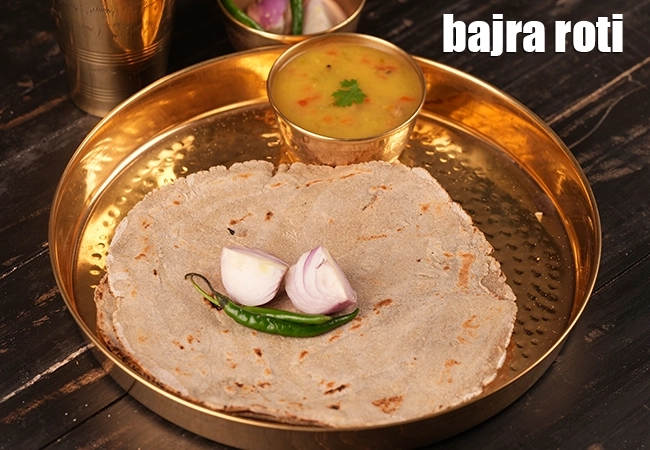
baked bajra chakli recipe | healthy Indian bajra murukku | kambu murukku | non fried chakli |
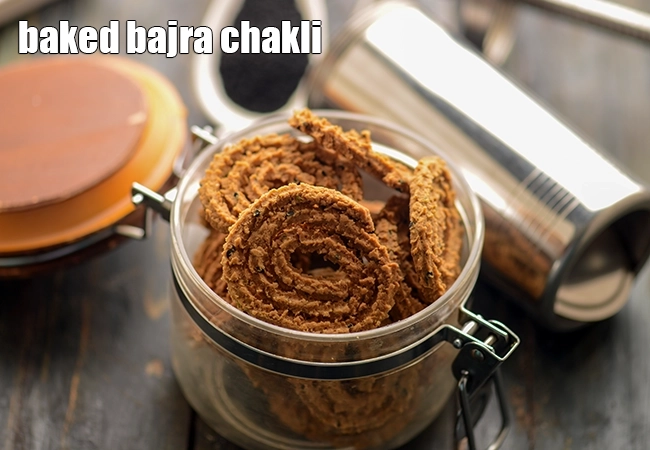
How to store bajra flour, bajra ka atta, bajre ka atta
• This flour is best used within 20 days.
• Store in an airtight container in a cool and dry place.
Nutritional Information of Bajra Flour
One cup of Bajra Flour is 130 g (which is obtained from 96 g of whole bajra), which makes 6 rotis.
RDA stands for Recommended Daily Allowance.
Nutritional Information for 1 cup Bajra Flour
346 Calories
11.1 grams of Protein
64.8 grams of Carbs
4.8 grams of Fat
284 mg of Phosphorus : 47.3% of RDA (about 600 mg for adult)
43.68 mcg Folate, Vitamin B9 (FA) = 43.68% of RDA (about 100 mcg)
10.84 grams of High Fiber = 43.3% of RDA (about 25 to 30 grams)
7.68 mg of Iron (Fe) = 38.4% of RDA(about 20 mg for women)
131.5 mg of Magnesium (Mg) = 37.57% of RDA (about 350 mg )
2.97 mg of Zinc = 29.7% of RDA (about 10 to 12 mg)
0.31 mg of Vitamin B1, Thiamine : 26.4% of RDA (about 1.2 to 1.5 mg)
0.24 mg of Riboflavin, Vitamin B2 = 21.8 % of RDA (about 1.1 mg)
11.1 g Protein = 20.1% of RDA (55 g)
2.2 mg of Vitamin B3, Niacin = 18.4% of RDA (about 12 mg)
294 mg of Potassium (K) :6.2% of RDA (about 4,700 mg)
126.7 mcg of Vitamin A = 5.2 % of RDA (about 2,400 mcg)
40.32 mg of Calcium (Ca) = 4.32% of RDA (about 1000 mg)
Health benefits of bajra flour, bajra ka atta, bajre ka atta
1. Bajra flour is High in Protein:
One cup of Bajra Flour makes around 4 rotis. So each Bajra Roti yields about 1.8 grams of protein which is a very good source for Vegetarian protein. This key nutrient is required to build muscle mass and nourish each and every cell of the body.
bajra roti recipe | bajre ki roti | healthy pearl millet roti | Rajasthani bajra roti | Sajje Roti
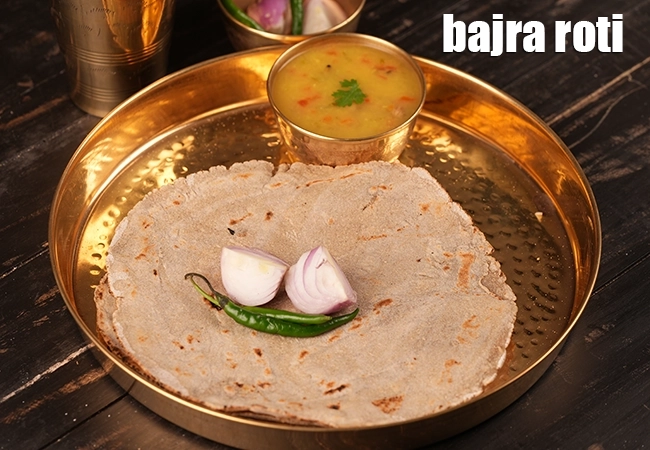
2. Bajra flour is High in Fiber :
Fiber is a key nutritent which is a best friend of your digestive system. It helps cleanse the gut and prevent constipation. It also keeps you full for long time and thus avoids binge eating and weight gain. Try this fiber rich flour for a satiating breakfast in the form of Bajra Onion Muthia.
bajra onion muthia recipe | Gujarati bajra muthiya | healthy onion bajra muthiya
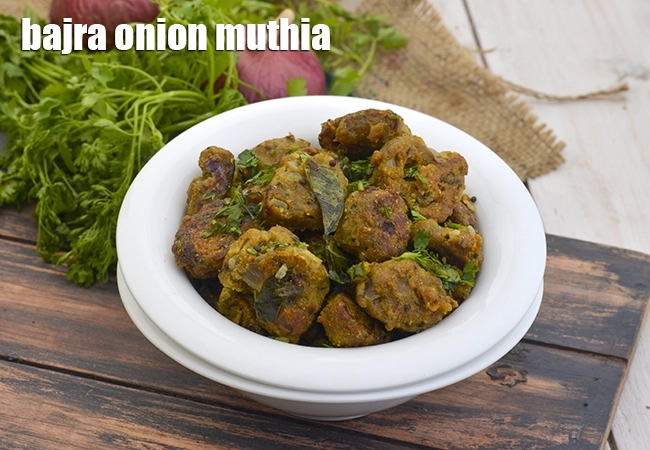
3. Complete Protein for Vegetarians :
Bajra Flour forms a complete protein when combined with legumes like rajma, moong dal, urad dal, toovar dal, chana dal. This is because bajra being a cereal pairs with legumes and pulses to make up for all the 9 essential amino acids humans need.
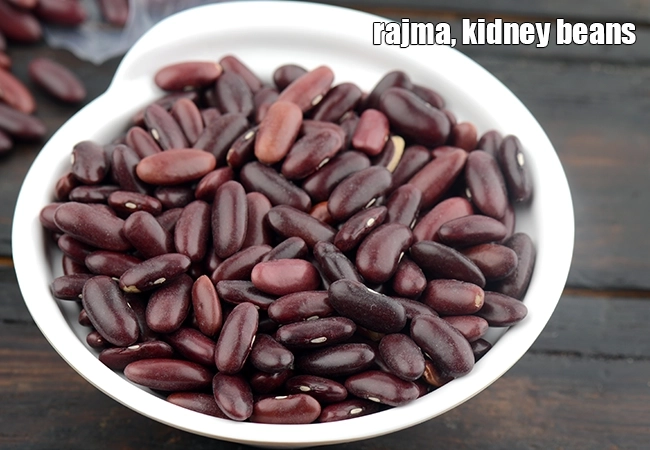
4. Bajra flour is Gluten Free :
Great healthy option for those who are intolerant to Gluten.
bajra aloo roti recipe | bajra aloo paratha | potato bajra paratha | masala bajra roti
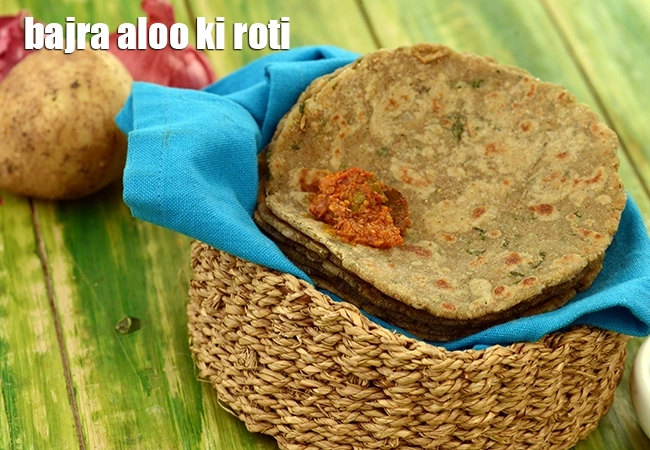
See detailed benefits of bajra flour
Glycemic Index of Bajra Flour, Black Millet Flour
Bajra flour has a Glycemic Index of 71 which is high. Glycemic Index are for foods you eat, ranks carbohydrate-containing foods by how quickly they digest and raise your blood sugar or glucose levels. Foods rank from 0 to 50 are low GI, 51 to 69 are medium and 70 to 100 are high. Foods that are high in GI are not suitable for weight loss and diabetics. Foods like Bajra flour have a high GI but since its rich in Fibre which results in Bajra being healthy and suitable for a healthy lifestyle as the Glycemic Load reduces.
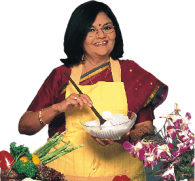
Related Glossary
Follow US
Recipe Categories
- Vitamin B12 Cobalamin Rich Recipes 33 recipes
- Low Calorie, Weight Loss Indian Recipes 421 recipes
- Low Cholesterol Indian Recipes 308 recipes
- Healthy Indian Breakfast 373 recipes
- Indian Diabetic recipes 559 recipes
- Indian Pregnancy recipes 461 recipes
- Zero Oil Indian Recipes 133 recipes
- Iron Rich Indian recipes 268 recipes
- Healthy Indian Acidity recipes 136 recipes
- Healthy Sabzis 108 recipes
- Indian Healthy Veg Snack 276 recipes
- Healthy Heart Recipes 415 recipes
- Healthy Veg Indian Soups 74 recipes
- Calcium Rich Indian Recipes 373 recipes
- High Blood Pressure Indian Recipes 103 recipes
- Healthy Indian Salads Recipes 137 recipes
- Low Carb Indian Diet, recipes 163 recipes
- Hypothyroidism Diet 63 recipes
- Arthritis Diet 68 recipes
- High Protein Indian recipes 95 recipes
- Vitamin K Diet 42 recipes
- Fatty Liver Diet 39 recipes
- PCOS 136 recipes
- Gluten Free Veg Indian 196 recipes
- High Fiber 328 recipes
- Indian Cancer Patients 275 recipes
- Jaundice Diet 45 recipes
- Sprouts 61 recipes
- Typhoid 43 recipes
- Irritable Bowel Syndrome (IBS) 23 recipes
- Kidney Stone Diet 10 recipes
- Home Remedies 213 recipes
- Senior Citizen 195 recipes
- Healthy Indian Drinks and Juices 213 recipes
- Diet for Dialysis 10 recipes
- Gout Indian Recipes 17 recipes
- Potassium Rich 80 recipes
- Vegan 195 recipes
- Indian recipes to treat Vomiting 8 recipes
- Forever Young Diet, Anti Aging Indian Diet 255 recipes
- Antioxidant Rich Indian 445 recipes
- Vitamin B1 Rich Indian Foods, Recipes 101 recipes
- High in Omega 3 Fatty Acids 32 recipes
- Zinc Rich Foods 55 recipes
- Vitamin A Rich, Beta Carotene, Retinol 89 recipes
- Malaria Diet 19 recipes
- Magnesium Rich 94 recipes
- Healthy Indian Dinner 85 recipes
- Vitamin C Rich Indian recipes 118 recipes
- Low Veg Glycemic Index 86 recipes
- Lower Blood Pressure Salads 8 recipes
- Healthy Indian Lunch Recipes 29 recipes
- Lactation 25 recipes
- Vitamin E Rich 51 recipes
- Hyperthyroidism Diet 47 recipes
- Vitamin B3, Niacin Rich 41 recipes
- Post Surgery Diet 42 recipes
- Selenium 27 recipes
- Lower Blood Pressure Desserts Sweets 14 recipes
- Phosphorus Rich Indian Recipes, Foods 74 recipes
- Copper 15 recipes
- Foods Rich in Vitamin B2 Riboflavin 22 recipes
- Vitamin B6 Diet 36 recipes
- B Vitamins 231 recipes
- Vitamin B9 Rich Folate 50 recipes
- Marathoners, Endurance Athletes, Triathlete 225 recipes
- Manganese Diet 32 recipes
- Thalassemia 18 recipes
- Detox Water, Fruit Infused Water 42 recipes
- Lactose Free Dairy Free 22 recipes
- Omega 6 Fatty Acids 32 recipes
- Phytonutrients 51 recipes
- Chronic Kidney Disease Indian recipes 12 recipes
- Selenium1 0 recipes
- Quick Snacks / Quick Starters 385 recipes
- Quick Breakfast Indian 131 recipes
- Quick Sabzis 117 recipes
- Quick Rotis / Parathas 46 recipes
- Quick Indian Sweets 139 recipes
- Quick Stir-Fries 51 recipes
- Quick Vegetarian Indian Soups 72 recipes
- Quick Chutneys 67 recipes
- Quick Vegetarian Rice, khichdi Recipes 56 recipes
- Indian snacks under 10 minutes 44 recipes
- Quick Indian Dips, Gravies & Sauces 105 recipes
- Quick Veg Indian Pizza 17 recipes
- Quick Veg Pasta 25 recipes
- Quick Pickles / Aachar 25 recipes
- Quick Dals / quick Kadhis 29 recipes
- Snacks under 5 minutes 33 recipes
- Quick Healthy Recipes 43 recipes
- Quick Pressure Cooker 46 recipes
- Quick Desserts 47 recipes
- Quick 3 Ingredients 63 recipes
- Quick Indian Desserts 20 recipes
- Quick 4 Ingredients 41 recipes
- Quick 5 Ingredients 42 recipes
- Kids Tiffin Box 319 recipes
- Recipes for Toddlers (1-3 Years) 32 recipes
- Sweet Recipes for Kids 456 recipes
- Recipes for Baby (10 to 12 Months) 17 recipes
- Quick Indian recipes for Kids 72 recipes
- Indian Breakfast Recipes for Kids 192 recipes
- Recipes for Weaning (8 to 9 months) 22 recipes
- Healthy Foods for Kids 196 recipes
- Snack Recipes for Kids 619 recipes
- Recipes Kids can make 36 recipes
- Kids After School 794 recipes
- Kids Jar Snacks 66 recipes
- Finger Foods for Babies, Toddlers and Kids 76 recipes
- Kids Weight Gain 43 recipes
- Kids Wraps and Rolls 23 recipes
- Kids Veg Pasta 27 recipes
- Kids Brain Boosting 68 recipes
- Protein rich food for kids 71 recipes
- Recipes for Weaning 15 recipes
- Kids Pizzas 30 recipes
- Babies, Toddler and Kids Iron Rich Foods 31 recipes
- High Fiber Foods for Kids 39 recipes
- Kids Noodles 37 recipes
- Kids High Energy Indian Foods 103 recipes
- Kids Calcium Rich Indian recipes 92 recipes
- Babies recipes, 6 to 18 months 34 recipes
- Kids Recipes for Increasing Immunity 10 recipes
- Kids Weight Loss 58 recipes
- Teething Recipes for Babies 10 recipes
- Cereals and Pulses for 8 to 9 months Baby 8 recipes
- Weaning foods at 7 months 12 recipes
- Indian Teen 315 recipes
- Starters / Snacks 2138 recipes
- Indian Breakfast Recipes 819 recipes
- Main Course Recipes 925 recipes
- Indian Salads 385 recipes
- Indian Desserts , Sweets 985 recipes
- Indian Soups 249 recipes
- Indian Beverages, Indian Drinks 483 recipes
- Indian Dinner 903 recipes
- Indian Dinner1 0 recipes
- Indian Lunch 829 recipes
- Side Dishes 449 recipes
- Indian Travel Food 433 recipes
- Indian Barbeque1 recipes 22 recipes
- Frozen Foods, Indian Freezer Recipes 67 recipes
- Whole Wheat Recipes 56 recipes
- Indian Comfort Foods 212 recipes
- Dinner Menus 56 recipes
- Easy Indian Veg 70 recipes
- Innovative Indian Recipes 27 recipes
- No Cook Indian 37 recipes
- Advanced Recipes 10 recipes
- Cakes with Eggs 13 recipes
- Microwave 229 recipes
- Oven 619 recipes
- Indian Steamer Recipes 102 recipes
- Kadai Veg 407 recipes
- Indian Barbeque Recipes 43 recipes
- Sizzler tray 15 recipes
- Mixer 566 recipes
- Pressure Cooker 315 recipes
- Tava 647 recipes
- Non-stick Pan 1393 recipes
- Indian Freezer recipes, meals 57 recipes
- Appe Mould 18 recipes
- Pan 223 recipes
- Non Stick Kadai Veg 203 recipes
- kadai Indian 150 recipes
- Refrigerator 176 recipes
- Waffle Indian recipes 6 recipes
- Handi 12 recipes
- Juicer and Hopper 65 recipes
- Grill 31 recipes
- Toaster 21 recipes
- Gas Toaster 8 recipes
- Steam 72 recipes
- No Cooking Veg Indian 335 recipes
- Vegetarian baked Indian recipes 380 recipes
- Boiled Indian recipes 129 recipes
- Deep Fry 260 recipes
- Indian Tawa 265 recipes
- Shallow Fry Indian 25 recipes
- Microwave1 172 recipes
- Saute 273 recipes
- Indian Pressure Cooker 171 recipes
- Stir-fry 101 recipes
- Roasting 0 recipes

















